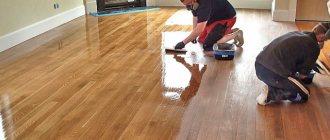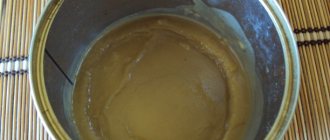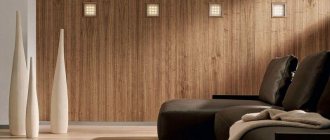A material such as wood has always been in demand, since it is a natural material and no newfangled plastics can compete with it in the ability to create an atmosphere of comfort and warmth in a room. But, like any other material, wooden products require protection and care.
For these purposes, special stains and varnishes are used. Treating wood with such means not only protects it from excessive exposure to light, moisture, scratches, and dirt, but also gives it nobility and sophistication.
How to paint wood with stain and varnish it
A material such as wood has always been in demand, since it is a natural material and no newfangled plastics can compete with it in the ability to create an atmosphere of comfort and warmth in a room. But, like any other material, wooden products require protection and care. For these purposes, special stains and varnishes are used. Treating wood with such means not only protects it from excessive exposure to light, moisture, scratches, and dirt, but also gives it nobility and sophistication.
- Why apply stain to wood? Water stain
- Alcohol stain
- Oil stain
- Preparing the wooden surface
Selection of materials
Varnishing wood requires the use of high-quality materials and tools. Depending on the purpose of the wooden product and the conditions of its operation, it is necessary to use varnishes that have suitable characteristics.
There are several types of varnishing material:
- Oil varnishes are made on the basis of synthetic or natural oils, to which special components are added that increase the strength of the coating. Most often, oil varnishes are used indoors to treat walls and floors. The finished coating is transparent, but has a yellowish tint;
- alcohol formulations are made by dissolving natural or synthetic resins in alcohol. Alcohol varnishes create a thin coating that is unable to provide high-quality mechanical protection for wood, but at the same time they make its top layer more moisture resistant. Very often such products are used for priming wooden surfaces;
- Nitrocellulose products are prepared by dissolving nitrocellulose in organic solvents. Special additives are added to the composition to increase the strength of the varnish coating. Nitrocellulose varnishes are applied, usually in several layers;
- acrylic varnishes are made on the basis of polymer acrylic resins. They can be used to create not only transparent, but also painted surfaces. These materials are very durable and environmentally friendly, but they can only be used indoors;
- alkyd varnish materials are made from synthetic resins based on inorganic solvents. The surfaces obtained using these varnishes are highly durable and resistant to moisture. All this makes it possible to use such varnishes to cover the facades of buildings and wooden elements located on the street;
- polyurethane compositions based on polymers make it possible to obtain a thin coating that is resistant to mechanical stress. Very often, such varnishes are used for processing musical instruments.
Surfaces located outdoors or indoors can be varnished. Modern means make it possible to protect even wood submerged in water. If there is no varnish, then it is replaced with drying oil or wax mastic, after which the wooden surface becomes slightly velvety to the touch.
Water stain and its specifics
Water-based stain is available as a ready-to-use liquid and as a powder that can be diluted to the desired concentration. Water-based stains have good adhesion, naturally highlight the grain of the wood and come in a wide range of shades, from light tones to deep dark reds. The absence of toxic odors makes such compositions indispensable when performing interior work.
When processing resinous wood, water stain may become stained due to uneven absorption into the structure of the material. In this case, it is recommended to subject the surface of the product to a de-tarring procedure.
Another disadvantage when working with water stains is the problem of raised lint. To eliminate this defect, the prepared surface is moistened with water and allowed to dry. Then the product is sanded with fine-grained paper and opened with a finishing compound.
Color spectrum
Beitz is a unique product that helps give wood a noble shade.
The structure of the wood is heterogeneous, different areas are impregnated unevenly, therefore, after the composition dries, an original pattern is created on the surface. The most popular shades of stains are included in the wood range; their names correspond to different types of wood. When purchasing, you should carefully consider the samples on which the stains are applied, because the shade on the label and in reality may not match. The finished color will depend on the following factors:
- original wood shade;
- degree of porosity of the material;
- density;
- breed;
- amount of resin.
Deciduous wood is impregnated much better than coniferous wood, so the tone will be as close as possible to the stated one. To give a light shade, you can purchase a lightening impregnation, which also tends to emphasize the wood grain. There are even colorless stains on sale that do not change the color of the wood, but still have full protective properties.
How to prepare wood for processing
Treating wood with stain is not such a simple process as it may seem to an ignorant person. To achieve the desired result, it is necessary to take into account some of the subtleties and nuances of this procedure, and also perform all stages of staining in order.
- First you need to choose a color, a suitable composition of the solution and tools for applying it. For quick-drying compounds, you need to prepare a spray gun or other sprayer. You can work with oil, water or acrylic stains with a brush, sponges, or swabs. It all depends on the size of the surface to be finished and the expected effect.
- Preparing a wooden product for painting involves drying the new surface or cleaning the old surface from the previous finish to the body of the wood. The dry product must be carefully treated with sandpaper or a grinding machine. To avoid the appearance of new defects, movements should be carried out along the fibers. Scratches, dents, and chips on an untreated surface may be inconspicuous, but after covering with wood stain they appear quite noticeably.
- By grinding the surface being treated is brought to a completely smooth state. Then the dust and removed fibers are removed. To do this, you can use a vacuum cleaner or a soft cloth.
- The next stage is degreasing, most often performed with white spirit.
- Before applying the base composition, especially water stain, the product must be moistened with clean water. And sand again.
Some nuances occur when preparing coniferous wood products for working with stains, especially those with high resin content. The fact is that after applying the stain, resinous areas can appear through the coating in ugly spots. It is best to first rid such wood of such manifestations. To do this, use one of the compositions:
- an aqueous solution of acetone, for this purpose mix 750 g of water and 250 g of acetone;
- a soda mixture consisting of one liter of warm water, 60g of soda ash and 50g of potash (potassium carbonate).
To get rid of the resin completely, the treatment must be performed several times. Then rinse the product thoroughly with soap and then with clean water. Dry and then carry out traditional preparation for staining.
Wood staining compositions made from coffee, tea and vinegar
Natural stains are good precisely because they are absolutely safe for human health - what bad things can happen from ordinary food products?
So, to give the wood a brown tint, you can do this:
- Brew the tea, let it brew, then strain out the tea leaves. The resulting composition can be impregnated with wood, saturating it with tannins (contained in tea). Depending on the amount of impregnation and the concentration of the brew, you can get many shades of brown.
- Ground coffee beans need to be brewed, infused and strained. Treat the wood with the resulting infusion. The color will be darker than in the previous case, and it depends on the strength of the resulting drink.
- You can add a little soda to the ground coffee - in a ratio of 1:4 (1 part soda to 4 parts ground coffee) and brew it the same way.
Vinegar is useful for giving wood a dark tint. True, you will need not only vinegar, but also small nails or iron filings (stock up if you know a metal turner).
The stain is done like this:
- Nails or shavings must be degreased and filled with vinegar.
- The container should be placed in a dark place and left for up to 7 days - depending on the desired color and concentration of stain.
- Then the wood is impregnated with stain. This process is called “ebonyization” - that is, giving the material a black tint. The method allows you to obtain various shades of black, but it is especially effective when used for staining species like walnut (with a high content of a substance such as tannin).
Using vinegar stain requires caution
Finishing wooden surfaces with stain: tips from TBM-Market specialists
To make the result pleasing, before starting finishing work you need to remember the simple rules of wood processing:
- To increase the depth of penetration into wood and improve adhesion to the surface, the composition should be slightly heated to a temperature of 36-38°C.
- The stain can be applied in different ways: rub in in a circular motion using a swab and longitudinally using a roller and brush.
- Wiping off excess must be done only along the fibers.
- To avoid blots and drips, do not dip the brush or swab into the solution too much.
- Do not apply a second layer of composition on the first one that has not dried.
- The ends and sections of wood that actively absorb the composition must be subjected to more intensive processing.
- Vertical surfaces of doors, panels, and walls should be coated starting from the bottom to prevent stains from being absorbed into unpainted wood.
- The procedure for applying layers can be repeated several times until the desired tone is achieved.
Surface preparation
All cracks on the wooden surface must be carefully puttied and sanded.
The varnish can only be applied to a sanded smooth surface. Regardless of whether the new material needs to be varnished or the old one, it must be carefully examined. All discovered seams, cracks and knots must be processed and eliminated.
Any gaps found between seams and joints must be sealed with special putty. After application, the putty is allowed to dry, and then, to remove possible unevenness, the putty areas are sanded again with fine sandpaper.
It is also necessary to take into account the fact that it is pointless to putty on raw or even under-dried wood, much less treat it with drying oil, stain or varnish.
When drying, the wood becomes deformed, and the applied layer will inevitably be damaged.
Types of tinting products
The main advantage of treatment with a tinting composition is the aesthetic aspect (the material takes on a decorative appearance). But there are other advantages: increased service life due to the antiseptic effect, preservation of texture, absence of toxic substances, the ability to combine different tones and colors, good adhesion to the processed wooden object, increased resistance to a humid environment, ease of use.
The process of treating with stain depends on its type; the classification includes several main types of tinting material:
- Water stain is the most budget-friendly and non-toxic option suitable for interior decoration. The compositions are sold in ready-made diluted form, or in powder form, which must be diluted with water. Water-based compositions are available in a wide variety of colors. The drying process is relatively long – up to 14 hours. Resinous species must be deresined before processing, wood with raised pile must be sanded. Powder compositions must be diluted with warm water. To make the solution a shade lighter, add a little more water.
- Alcohol stain - consisting of an alcohol base and aniline dye. The product is also available in two states: dry and liquid. Unlike water-based stains, dry substances are diluted with alcohol. In general, in order not to confuse what to dilute with, you need to carefully study the instructions. Alcohol stains dry much faster - in half an hour. Attention! When working with these solutions, ventilate the room, otherwise you will get poisoned by inhaling the vapors. The evaporation process lasts only 30 minutes, so during this time there will be a maximum concentration of toxic substances from denatured alcohol.
- Oil stain - characterized by resistance to ultraviolet radiation, the solution is based on oil (often linseed), so the richness of the pigments remains for years. How long such a composition dries depends on the concentration, temperature, and other factors. On average, the period is within 2-4 hours. Application is even easier, the result is the most uniform layer possible, the pile does not rise.
- Acrylic or wax - with excellent moisture-proof properties. But the coating is not protected from mechanical damage. The compositions are applied easily, without streaks, and maintain the same tone. The choice of colors is wide, well suited for restoration work on parquet and furniture. A whole range of factors influence how long it takes wood stain to dry, but the average time for complete drying is between 4 and 5 hours.
- Nitromortar – similar in properties and method of application to alcohol stain. They need to quickly cover wooden structures; a good option is to use sprayers.
What to apply?
For staining at home, use brushes, foam sponges, swabs made of soft absorbent fabric, ordinary paint rollers, and spray guns. The choice of tools and equipment is influenced by the type of composition and its drying time.
Water stains are applied with a brush, roller, swabs; for alcohol and nitro stains, spraying with a spray gun is recommended - this way the consumption is more economical, the quality of the coating is several times higher. For oil and acrylic compositions, lint-free cloth swabs and wide brushes are equally good for application.
Features of the composition for painting
Whether you need to repair old doors or give new ones a different look, choosing the right paint product is very important. The quality and service life of a wooden door depends on it. Let's look at the most common means.
Varnishes – colored, glossy or matte. Their main property is that the structure of the wood will definitely be visible under the layer of substance. If you have completely restored the door, then varnishing is unlikely to be suitable, since all the defects and subtleties of processing will be visible. There are several varnish options:
- oil based;
- alcohol varnish;
- polyurethane;
- solvent-based nitrovarnish.
The latter type is not suitable for use on wood: the composition of this varnish has a bad effect on wood. But polyurethane varnish is durable and resistant to mechanical damage, so it is perfect for our task, although it is quite expensive.
The choice of varnish or paint depends on the type of door and its location in the room
If painting with varnish is not suitable for you, turn to paints. Their choice on the modern market is huge both in color and composition, and it will not be difficult for you to give the door any look. Paints can be matte, glossy or emphasizing the wood structure
The main thing is to pay attention to what base the product is made of - oil or alcohol. Nitro paint is also suitable
There are also oils containing wax intended for painting wooden surfaces. This product can be transparent or colored; it will give the wood a soft silky feel. The disadvantage of this material is its high cost.
Compositions for different types of doors
When choosing a paint product, pay attention to the condition of the door leaf. As already mentioned, for an old door that had to be restored, a varnish coating under which the entire surface is visible is absolutely not suitable
In this case, it is better to use paint. The varnish will look good on the new door.
The modern market offers a large selection of paints and varnishes for wooden doors
There are 2 types of paints and varnishes most often used in such work.
- Acrylic compositions on a water-dispersion basis. They are easy to apply and adhere well, as if covering the surface with a thin layer of plastic. There is no pungent odor when drying.
- Alkyd paints and solvent-based varnishes. When painting, they penetrate deep into the wood structure and dry quickly. They withstand temperature fluctuations and have a water-repellent effect. The disadvantages include a strong odor when drying.
Taking these points into account, we can conclude that acrylic compositions are well suited for interior doors and dry rooms. Alkyd paints are best used on entrance doors or in damp rooms
If you plan to paint the door one color, then the choice of coloring material will be based on the above criteria
But if you have a door leaf with a design, take into account the following:
- matching the color of the floor, wall cladding, furniture;
- antique decor or a certain style - high-tech, country, etc.;
- contrast of individual parts (relevant for paneled models);
- wood structure;
- applied drawing. This diagram will help you choose the type of wood by color
Please note: paints must be applied to a completely dry surface. Otherwise, the paint layer on damp wood will begin to peel and flake off.
How to stain wood?
There are four main ways to treat wood with stain. We will look at three of them, since painting with a spray gun is a more professional option. Not everyone has such equipment.
- Processing with stain by lowering small parts directly into a container with stain. Since this exotic method is more suitable for various wood crafts.
- Applying stain using a brush. The stain is applied with a soft natural brush.
- Painting wood with stain using a roller or swab. The roller should be medium or narrow, with short or medium pile. A foam roller is suitable for water-based stains.
What is the best way to apply stain?
Wood staining is done with the following tools: a brush, a foam rubber or fabric swab, a roller and a spray gun.
When tinting the surface with alcohol-based stain and nitro stain, use a spray gun. These liquids dry out quickly, and brushes on the surface leave stains. The spray gun is also convenient to use for treating large areas.
Tools for applying stain to wood
For other types of stain, use a swab, rag and brush. It is necessary to choose a brush with strong bristles so that no hairs remain on the painted wood. Rags and tampons should also be of high quality, since lint and threads remaining on the surface will create an unattractive appearance of the paint.
Oil stains are used to paint wood with brushes with natural bristles, while water-based stains can also be used synthetically.
Work technology
The method of applying it depends on the type of stain. Typically, a brush, spray, swab, or sponge are used for painting work. It is better to treat unsmooth and large-sized bases with a spray gun (in the first case, do not use a brush so that there are no fallen bristles left on the wood). To use a sprayer, choose a lighter shade of stain: the layer will be thicker, making it appear darker.
Before the main stage of work, a test painting is always carried out to clarify the required number of layers to obtain the desired shade. The procedure is as follows:
- take a board of the same type as the base material and polish it;
- cover the product with impregnation;
- leave until dry;
- apply another layer to 2/3 of the board;
- after drying, treat another 1/3 of the workpiece with a third layer;
- As it dries completely, evaluate the appearance of all three areas and select the optimal shade.











